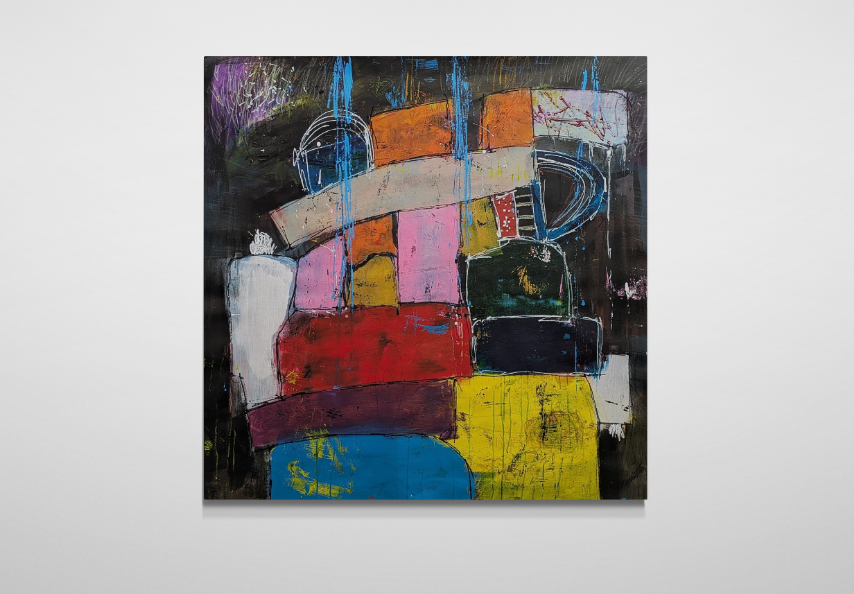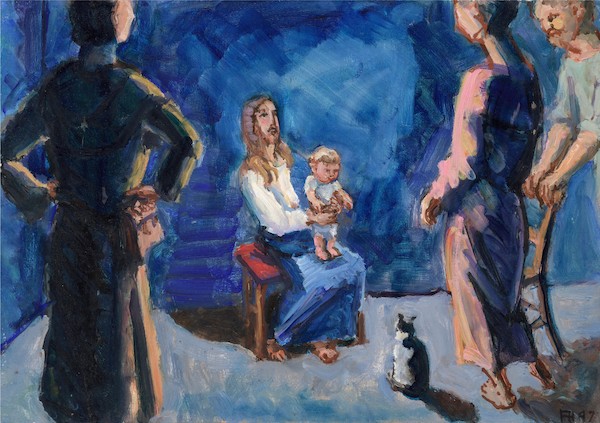Theme, style and motif in the sixteenth and seventeenth centuries
The work by Rubens that we discussed in the previous article [Abduction of the daughters of Leucippus] presents us with a problem that occurs again and again when we study the art of the seventeenth century. Imagine that we were not acquainted with the theme. In that case it would be very difficult to figure out what Rubens had in mind. Only by chance might we be able to determine the subject. Sometimes there is a tradition of a certain theme – we will come back to that – so that one knows it from experience, but that is not the case here.
But even when we have determined what the theme is, we may get the strange feeling that we have still not learned anything essential about the work of art. It has not become clearer; we are no closer to understanding it; it has not become more beautiful or more meaningful. And we may be inclined to lament that ‘the subject seems to be irrelevant!’
Such a conclusion would appear to conflict with everything that we know of the seventeenth-century artists and their patrons. Besides, if the theme were of no importance, then why would the painters so often choose biblical or classical themes? Genre painting, with its straightforward love for realism, would then have been more appropriate. But even there one often has the feeling that the paintings have an added dimension besides picturing a small piece of the artist’s world. This may also be found in some works from the nineteenth century, but that art is often dull and inconsequential in contrast with the art of the seventeenth century. In short, there is something like a riddle hidden in seventeenth-century art that cries out for a solution.
Often in sixteenth- and seventeenth-century works we see a naked female figure committing suicide. To assume that it is all about nakedness is not really convincing: these dying women are after all not really a stimulating or inviting sight. We learn that the subjects in these pieces can be Lucretia or Thisbe, or Dido or Panthea, or others – all committing suicide with a dagger or, related to this, like Cleopatra, by letting herself be bitten by a poisonous adder. What could possibly be the point of all these pieces in which we are sometimes quite unclear as to exactly what the subject is?
We find the key to the solution from de Ripa who in the early seventeenth century wrote a book about allegories etc. (entitled Iconologia). In his book we learn that despair is symbolized as a woman committing suicide with a dagger. The conclusion becomes clear: all of those paintings are intended to denote Despair. We call that the motif, the general human concept. The themes are then taken from the Bible or from classical antiquity as settings of evidence. They also give a certain flavour to the despair: Dido was abandoned by her lover, Lucretia lost her honour, Thisbe lost her lover, etc.
Especially by studying prints (etchings and engravings) one often comes to understand more clearly the significance of certain themes – i.e. which general human motif is their source. So we find, for example, a series of prints by Galle that brings together Eve and Adam, Sisera and Jael, Delilah and Samson, Solomon’s wives who led him into idolatry, Judith and Holofernes, and many more. As you may have noticed in each case we named the woman first. For the unifying motif underlying these diverse themes is that of ‘the dangerous woman’.
Compositionally these representations of Old Testament subjects have nothing to do with each other. Still, it is by studying certain figures that reappear, again and again, in a particular position (which in some art history books is called ‘motif’, a word I avoid here because I mean something different by it) that we move forward in our understanding. I rather use the term ‘formula’ to indicate a certain compositional or artistic combination of figures, or a single figure in a specific position. We find such a formula, for example, in the reclining female nude figure. It was introduced in the history of art by Giorgione’s famous Venus figure. Venus, symbolizing Love and Beauty, occurs again and again as a fixed formula in all sorts of different themes. And in this we find the key to Rubens’s painting Cimon and Iphigenia – there are besides this many other examples of the same theme in this formula. It pictures a sleeping female figure and a man standing nearby watching her. The scene is taken from a story from Boccaccio’s Decamerone and concerns Cimon, a half crazy, rough, simple, boorish character. When by chance he happens upon the nearly naked sleeping Iphigenia he is so touched by the sight that from that moment on he becomes a gallant, intelligent gentleman. We note in passing the influence of Platonic ideas on this work: Beauty and Love inspiring man towards nobility and greatness – we could call it the motif of this theme. The formula of the reclining female figure is very often used for this idea. She might be Psyche (who inspires Amor), or Danae (as pictured by Rembrandt). The woman (in this instance his wife Saskia) as the inspiration behind his work is the actual subject of the piece. One should note that also in the work by Rubens mentioned at the beginning of this article the reclining female is seen. That work also includes the motif (and we can see it even when we do not know the theme of the painting) of the woman as inspiration for male activity. Rubens has complicated it a bit by, as it were, contaminating it with another related motif, namely that of the raid (which we also find again and again with many variations: the raid of the Sabinian virgins, Pluto and Proserpine, Neptune and Amphitrite, etc. – sometimes in the same formula, sometimes not).
In closing we shall look at one more motif, that of the endangered woman. Here we often find the formula of the sitting female figure, frequently, though not always, in the nude: Susanna in her bath (waylaid by the two elders), Pomona and Vertumnus (the young innocent girl ensnared by the man who has disguised himself as an old woman; we think of the beautiful painting by Moreelse in the Boymans-Van Beuningen Museum) and, finally, Bathsheba, which reminds us immediately of the famous work by Rembrandt that can be seen in the Louvre.
To summarize we may conclude that the seventeenth-century artists started with a motif (pride, despair, various combinations of male-female relationships, love for the elderly, love of children, justice, generosity, etc.), and sought to express these by means of a theme that would colour the motif in a certain way. Those themes, often taken from the Bible or from ancient mythology, are also called exempla (that is how van Mander, for example, calls them in his Schilderboeck of 1604); they are, as it were, places of evidence (examples) of what the motif is expressing. Next the artist draws on artistic tradition to choose a formula. Sometimes there is a strong correlation between motif and formula, but this is never binding. One frequently finds that a certain motif can also be expressed via a very different, not necessarily traditional, formula. The motifs are always human in nature. Sometimes they also deal with people in their relationship with the spiritual realm or the supernatural. For example, they might be concerned with a person’s relationship to God and use the conversion of Paul as a theme. It is not easy to draw up a comprehensive list of motifs, and new variations are always possible; yet in principle the list is limited in number. This gives seventeenth-century art its unity, its depth, despite the huge diversity of forms. But because the motifs can be presented in so many ways (with various themes, and in various formulas), there is no end to the number of possible variations – far more than, for example, in the Middle Ages with its much more limited choice of themes.
Instead of a theme from the Bible or from antiquity, a subject from the world surrounding the artist could also be chosen; in that case we are dealing with a genre piece (e.g. as to the motif of the woman being the inspiration for the man, think of the romping couple by Jan Steen exhibited in the Lakenhal in Leiden). Thus it appears that genre paintings can also possess an added dimension.
If the artist depicts the motif directly, without, as it were, a theme, then we are dealing with an allegory or an allegorical figure as, for example, the above-mentioned Despair. In one of his prints Bruegel presents the figure of Prudentia, surrounded (as exempla of the same motif) by genre scenes: people propping up a house, making provisions for winter by stacking wood and salting meat; calling a doctor and a pastor to a sickbed, etc.
The content of seventeenth-century artworks, then, is to be found in the motif, which one can often recognize and understand even if one does not know the theme or is not familiar with the story. For example, we might see a woman weeping over a dying man – that is clear, even though we do not realize that they are Tancred and Armida. So it turns out that the content of seventeenth-century art cannot be found in the theme as such, and also not in the style (which in that time was not a carrier of meaning in the narrow sense). That artists tried to depict the motif, theme, and formula as beautifully as possible speaks for itself: the goal of the painter, after all, is to aim for the highest achievement.
For other articles belonging to this series, see the articles ‘About the Content of Works of Art’, ‘About the Content of Medieval Works of Art’; ‘The Art of the Fifteenth Century’; ‘Baroque Art’; ‘Principles of Nineteenth-Century Art’ and ‘Form and Content of Modern Art’. These articles were originally published in Dutch from 1963–1965 in Ad Fontes.
Published in M. Hengelaar-Rookmaaker (ed.): H.R. Rookmaaker: The Complete Works 4, Piquant – Carlisle, 2003.
%20(1).png)












